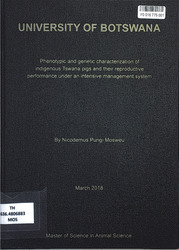| dc.description.abstract | Twelve FAO-lSAG-rccommended microsatellite markers were used to analyse genetic variation in Tswana and Tuli cattle breeds. All loci were polymorphic and a total of 75 and 77 alleles were genotyped in the Tswana and Tuli breeds, respectively, across all loci. The number of alleles per locus ranged from 2 (BM1818) to 10 (TGLA227) in Tswana cattle and from 3 (BM1818 and ILST006) to 10 (TGLA227) in Tuli cattle with mean number of alleles (A INA) per locus of 6.25 and 6.43, in the two breeds, respectively. A total of 103 unique alleles were genotyped across the two breeds with a total of 4 9 shared alleles between the two breeds. 26 alleles and 28 alleles were unique to the Tswana and Tuli breeds, respectively. The mean number of shared alleles per locus across the 12 loci was 4.08. The observed heterozygosity ranged from 0.200 (CSSM66) to 1(BM1818) and from 0.00 (CSSM66) to 1 (BA11818) in Tswana and Tuli cattle, respectively, with higher mean observed heterozygosity in Tswana than Tuli cattle (0.6311 vs. 0.555). The PIC values ranged from 0.375 (BA11818) to 0.844 (ETH225) in Tswana cattle and from 0.535 (1NTRA23) to 0.833 (TGLA227) in Tuli cattle with mean PIC values of 0.6355 and 0.7156 in Tswana and Tuli cattle, respectively. The within-population inbreeding estimate (Fix) of both Tswana and Tuli cattle were significantly positive. The Fis estimates ranged between -0.054 (TGLA227) and 0.769 (CSSM66) in Tswana cattle and between -0.2 (BAf 1818) and 1.00 (CSSM66)
in Tuli cattle. The within population inbreeding coefficient were 0.20 and 0.332 in Tswana and Tuli cattle, respectively. Tswana cattle were not in Hardy-Weinberg equilibrium at CSSRM60 and CSSA166 marker loci while Tuli cattle were not in Hardy-Weinberg equilibrium at ETH10, ETH225 and CSSA166 marker loci and the rest of the markers were in Hardys Weinberg equilibrium in the two breeds. Considerable allelic diversity and genetic diversity exist in bothTswana and Tuli cattle breeds and there was no significant difference in the level of genetic diversity' between the two breeds. The genetic identity between Tswana and Tuli cattle breeds was 0.564 indicating that there is 56% genetic similarity between the two breeds. Painvise genetic differentiation (Fst) value between Tswana and Tuli cattle was 0.0676 indicating that approximately 6.8% of the total genetic variation corresponded to differences between the two breeds, while the remaining 93.2% corresponded to differences among individuals. Tswana and Tuli cattle breeds are thus highly genetically related and therefore crossbreeding between the two breeds is unlikely to benefit from heterosis. | |




